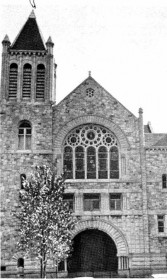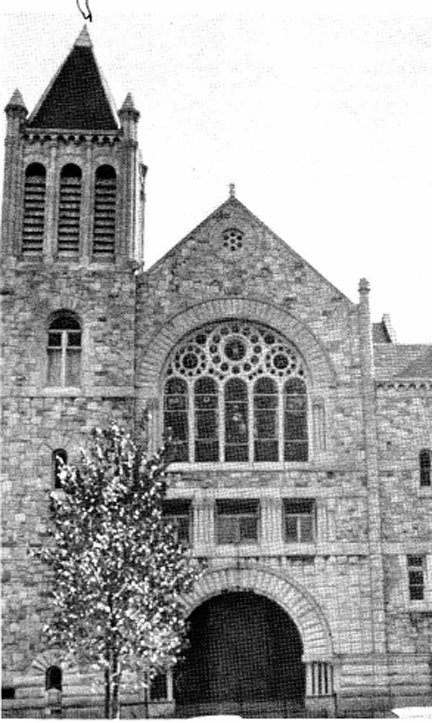History This Week – No.11/2010
By Cecilia McAlmont
Introduction
In the previous article, the early life and conversion of Richard Allen, founder and first bishop of the AME church were discussed. His early ministry and the circumstances surrounding the “exodus” in 1787 of black congregants from St George’s Methodist Church due to the deliberate acts of humiliation of the white elders were also examined. In this article, the establishment and evolution of “Mother Bethel” as the first church of the AME denomination, the international outreach of the AME church under Bishop Allen and his successors will be examined. Finally, the differences between the AME church and the AME Zion Church will be explained.

Mother Bethel
Not only was Allen’s wish to construct a separate building where African Americans could worship in comfort and dignity and not as second class Christians turned down by the elders of the Methodist church, he was threatened with expulsion if he did not abandon the idea.
Nonetheless, Allen remained a staunch Methodist because he felt that the gospel as taught under Methodism “the plain and simple gospel suited best for my people, for the unlearned can understand and the learned are sure to understand.” Allen and his supporters were further threatened by another elder to be read “publicly out of the meeting” and to be disowned by the Methodist Connection.
However, Allen was befriended by two white anti-slavery philanthropists who advised him and contributed to the purchase of an old blacksmith’s shop for $35. It was removed to a lot owned by Allen. That humble blacksmith’s shop was the foundation of the Black Methodist church and is regarded as the oldest piece of property owned by African Americans continually. The building was dedicated as the first church in July 1794. Bishop Francis Asbury of the Methodist Episcopal Church preached the dedicatory sermon. In his prayer, he expressed the hope that the church building would become a “Bethel” for those who worshipped there. According to AME history, the word Bethel is constructed from two Hebrew words – Beth meaning “house” and El meaning “God” hence “House of God.” Allen and his followers named the church “Bethel”.
Bethel was to face several ‘post dedication blues’. A white pastor, Rev Ezekiel Cooper recommended that the Bethel property be incorporated and offered to do it. The offer was accepted but the church was incorporated under the Methodist Con- ference. This meant that the church belonged to the white Conference. The depth of this deception was realized when a new pastor appointed to take charge in Philadelphia. According to Allen’s autobiography, he soon demanded “the keys and books of the church and forbid us from holding any meeting except by orders from him”. This was the beginning of nearly a quarter century of contentious confrontations and legal battles between Allen and Bethel’s congregants and the leaders of the Methodist church in Philadelphia. It was not until January 1816 that Allen and church members won the court case which recognised their right to exist as an independent church. In April 1816, the first Convention was held in Bethel where it was resolved that “the people of Philadelphia, Baltimore and all other places who should unite with them shall become one body under the name and style of the African Methodist Episcopal Church.” It thus became the first independent black denomination in the United States. At the same Convention, Richard Allen was elected as the first Bishop.
From the pulpit of Mother Bethel was heard the voices of many prominent citizens and abolitionists denouncing slavery. They included, among others, Lucretia Mott, Frederick Douglass, William Still and Alfred Love. Additionally, Mother Bethel became an important stage in the Underground Railroad to Canada. In its basement, many runaway slaves were sheltered, fed and clothed and large sums of money collected in the name of freedom.
The leader in the activity of harbouring runaway slaves was Richard Allen’s second wife, Sarah Bass Allen, a freed woman from the Isle of Wight in Virginia. She actually hid runaways in her home jeopardising the security of her family and her husband’s position. Over the decades, the AME church has produced many strong, militant black women like Sarah Allen. Perhaps the best known to us is Rosa Parks. Her act of disobedience caused by her refusal to give up her seat to make room for a white passenger sparked the Montgomery Bus Boycott. Described by the US Congress as the “Mother of the Modern-Day Civil Rights Movement,” Rosa Parks was a Deaconess in the Montgomery AME Church.
After the 1863 Emancipation Proclamation, Bethel received and helped many former slaves who came to Philadelphia. The present Mother Bethel, the fourth church was completed in 1890. In its crypt, lies the tomb of Richard Allen who died in 1831.
Richard Allen the Internationalist and the world wide mission of the AME church
One of his biographers, Guyanese born retired AME Bishop, Frederick Hilborn Talbot stated that Richard Allen “a Bishop in an infant denomination, with limited financial resources would have an international vision. Clearly his vision led him to think globally and act nationally. . Allen looked upon the world as his parish. The mission field was everywhere.” From the initial years of the AME church, the expansion of the denomination was not restricted to American soil. Richard Allen had a special interest in independent Haiti and endorsed a mission to that country in 1824. On American soil, the denomination expanded from the Middle Atlantic States NE to New England and Westward to Missouri. About a decade after Richard Allen’s death, churches were established in the slave states of Kentucky and Louisiana. It is stated that the most significant era of denominational development of the AME church in America took place during the civil war and reconstruction. “Oftentimes with permission of Union army officials AME clergy moved into the states of the collapsing Confederacy to pull newly freed slaves into their denomination.”
Richard Allen’s international vision of a worldwide parish was vigorously pursued by his successors. By the 1840s, in addition to Haiti, the denomination had spread to Canada and African Methodism was seen as “a religious refuge for persons of colour within the Western hemisphere.” The Dominican Republic, Barbados and Cuba became part of the denomination in 1874, 1893 and 1898 respectively. As early as 1856, with the re-establishment of the Canada Annual Conference as the British Episcopal Church, the church was extended to Bermuda and British Guiana. In 1891, the energy and vision of Bishop McNeal Turner led to the organization of the church in Sierra Leone and Liberia. In the 1950s AME churches were started in Ethiopia. In the 1960s the church was started in India, in 1966 in Britain and from there it spread to Holland. In the 1990s the church was established in Angola, the Ivory Coast, Togo, Uganda, Democratic Republic of Congo, Rwanda, Burundi, Kenya and the Republic of South Africa. In 2004, the 20th Episcopal District composed of Zimbabwe, Malawi, Tanzania and Uganda was established.
The AME and the AME Zion churches
The General Conference is the highest decision making body in the AME church. It meets every four years and is attended by four members, including the Bishop, from each of the twenty Episcopal districts of the church. Each Episcopal district is governed by the decisions taken at its Annual Conference which is spearheaded by its bishop and Presiding Elder(s).The Guyana-Surinam annual conference is one of seven in the 16th Episcopal district. Its Presiding Bishop is the Rt Rev Sarah Francis Davis and its presiding Elder and current pastor of the local Chapel, St Peter’s AME church is the Rev Andrew C Morris-Grant. Guyana has made a small but significant contribution to AME history. The Rev Frederick Hilborn Talbot became the first, and so far, the only Guyanese born bishop of the AME church. He made history when in 1973 he appointed the Rev Dorothy M S Morris as the first female Presiding Elder in the history of the AME church.
However, it is important to note that the African Methodist Episcopal Church and the African Methodist Episcopal Zion Church are two different African denominations although they share several things in common. Like the AME church several acts of discrimination by the elders of the John Street Methodist Church attended caused many black Christians to leave and start their own institutions. In 1796, Peter Williams formed the basic structure of the AME Zion Church in New York and in 1801 Zion Chapel began. In Guyana, the AME Zion church has its Chapel on Regent Street in the vicinity of Bourda Market while the Chapel of the AME church is situated at the comer of New Garden and Lance Gibbs streets.

